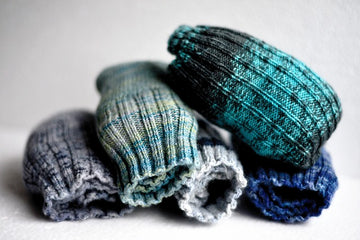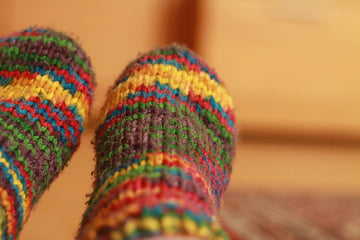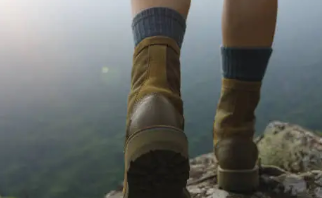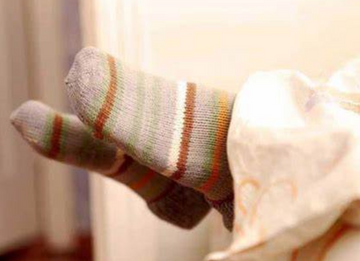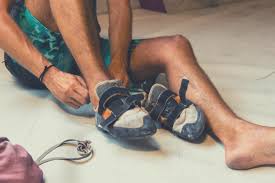
The question of whether or not to wear socks with climbing shoes is a common one among climbers of all levels. There's no single right answer, as the ideal approach depends on several factors like personal preference, climbing style, and even the environment. This article will delve into the pros and cons of both sockless climbing and climbing with socks, helping you decide which method best suits your climbing needs.
Do You Wear Socks with Climbing Shoes
Going sockless
-
Pros
Better feel for the holds: Without the barrier of socks, your feet can more accurately sense the texture and shape of the climbing holds, enhancing your overall climbing experience and performance.
Tighter fit: Climbing shoes are designed to fit snugly around your foot to maximize precision and control on the rock. Going sockless ensures that your foot is directly in contact with the shoe, minimizing any potential slippage or movement inside the shoe.
-
Cons
Hygiene: Climbing shoes tend to accumulate sweat and odor over time, especially if worn without socks. This can lead to unpleasant smells and bacterial growth, which may require more frequent cleaning and maintenance.
Comfort: For some climbers, particularly beginners or those with sensitive feet, wearing tight-fitting shoes without socks can cause discomfort, chafing, or even blistering, especially during extended climbing sessions.
Sweat: Without the absorbent layer of socks, sweat from your feet can accumulate inside the shoes, making them slippery and less comfortable to wear.
Wearing socks
-
Pros
Hygiene: Socks act as a barrier between your feet and the climbing shoes, absorbing sweat and reducing the growth of odor-causing bacteria. This can help keep your shoes fresher for longer periods between cleanings.
Comfort: Thin, moisture-wicking socks can provide an extra layer of cushioning and protection, reducing friction and minimizing the risk of blisters or hot spots, particularly during long or strenuous climbs.
Breaking in new shoes: If you have a new pair of climbing shoes that feel uncomfortably tight, wearing thin socks can help stretch them out slightly and make the break-in process more manageable.
-
Cons
Reduced feel: Wearing socks can diminish the sensitivity and tactile feedback between your feet and the climbing holds, potentially impacting your ability to gauge the precise positioning and pressure needed for certain moves.
Fit: Depending on the thickness of the socks, they may alter the fit of your climbing shoes, making it more challenging to achieve the desired snugness and precision fit that is crucial for high-performance climbing.
Additional considerations
Opt for thin, snug-fitting liner socks made from moisture-wicking materials like merino wool or synthetic blends to minimize bulk and maximize comfort and breathability.
Beginners or climbers with sensitive feet may find wearing socks more comfortable and forgiving, while more experienced climbers may prioritize performance and prefer the direct feel of going sockless.
For outdoor climbing in hot or humid conditions, wearing socks can help manage sweat and reduce the risk of developing blisters or discomfort during long multi-pitch routes or extended bouldering sessions.
Why Do Climbers Not Wear Socks?
Climbers often choose not to wear socks with rock climbing shoes for several reasons, with the primary consideration being performance.
Climbing shoes are designed to fit snugly around the foot, providing maximum precision and control on the rock. Wearing socks can add an extra layer of bulk, potentially compromising the tight fit needed for optimal performance.
Without the barrier of socks, climbers can experience a more direct connection between their feet and the climbing holds. This increased sensitivity allows them to better gauge the texture, shape, and nuances of the rock surface, which is crucial for making precise movements and adjustments while climbing.
The absence of socks allows climbers to maximize the surface area of their feet in contact with the shoe, enhancing friction and grip on the climbing holds. This can be especially important when attempting challenging routes that require intricate footwork and precise placement.
Socks can potentially increase slippage inside the shoe, leading to less stability and control during climbs. Going sockless ensures that the foot remains securely in place within the shoe, minimizing any unwanted movement or shifting.
While going sockless may offer performance benefits, it's essential to consider individual comfort and hygiene preferences. Some climbers may find that wearing thin, moisture-wicking socks provides a balance between comfort and performance, particularly during long climbing sessions or in shoes that feel overly tight or uncomfortable.
What shoes do you not wear socks with?
Loafers and slip-on shoes, like those from Skechers, UCB (United Colors of Benetton), or Vans, are commonly worn without socks due to their casual and breathable design. Crocs, being lightweight and water-resistant, are also often worn without socks, especially in warm weather or for activities like beach outings or gardening.
Shoes made of canvas or linen material, such as Toms®, Converse®, and Vans®, are typically designed to be worn without socks.
- Breathability
Canvas and linen are natural, breathable materials that allow air to circulate around the foot, helping to keep it cool and comfortable, even on warm days. This breathability helps prevent the buildup of moisture and odor inside the shoe.
- Moisture-wicking
Some shoes, particularly those with suede or fabric insoles, are designed to wick away moisture from the foot, further enhancing comfort and reducing the risk of sweaty feet.
- Comfortable fit
These types of shoes often have a relaxed, casual fit that is meant to be worn without socks. The soft, flexible material conforms to the shape of the foot, providing a comfortable and snug feel.
- Style
The aesthetic of canvas and linen shoes is often associated with a sockless look, emphasizing their casual, laid-back vibe. Many people choose to wear these shoes without socks to complement their style and enhance the overall look.
While these shoes are typically worn without socks, some individuals may prefer to wear no-show or low-cut socks for added comfort or to minimize friction. Ultimately, the choice to wear socks with canvas or linen shoes depends on personal preference and comfort level.
Is it OK to not wear socks with boots?
Wearing socks with boots is recommended for comfort, moisture management, protection against chafing, and warmth. The choice of sock length depends on personal preference and the style of the boots, with options ranging from ankle socks for ankle boots to knee-high socks for taller boot shafts.
Why do guys not wear socks with dress shoes?
Should you wear socks with hiking shoes?
Wearing socks with hiking shoes is generally recommended for several reasons. Crew-length socks are commonly worn to prevent higher boots from rubbing against the ankle, providing added comfort and protection. However, if you're wearing low-top hiking shoes, opting for socks that stop just above the cuff can help keep your feet cooler while still providing some coverage and protection.
Can you wear hiking boots without socks?
While it is technically possible to wear hiking boots without socks, it's generally not recommended due to several potential risks. Going sockless may lead to discomfort, chafing, blisters, and increased risk of odor and bacterial growth due to sweat buildup. However, some individuals may still prefer the feel of going sockless for personal reasons. If you choose to hike without socks, it's advisable to bring a spare pair with you in case of discomfort or to manage any unexpected issues that may arise.
Final Words
Ultimately, the best way to determine if you should wear socks with climbing shoes is through experimentation. Try both methods and see what feels most comfortable and allows you to perform at your best. Consider the additional factors mentioned, like sock type and climbing conditions, to further refine your approach. Whether you climb sockless for optimal feel or prefer the added comfort and hygiene benefits of socks, there's a method that will help you conquer the wall in style.
Read More:
Why Do We Wear Socks
Do You Wear Socks with Climbing Shoes
What Color Socks with Brown Shoes
What Socks to Wear with Loafers
What are Grip Socks




